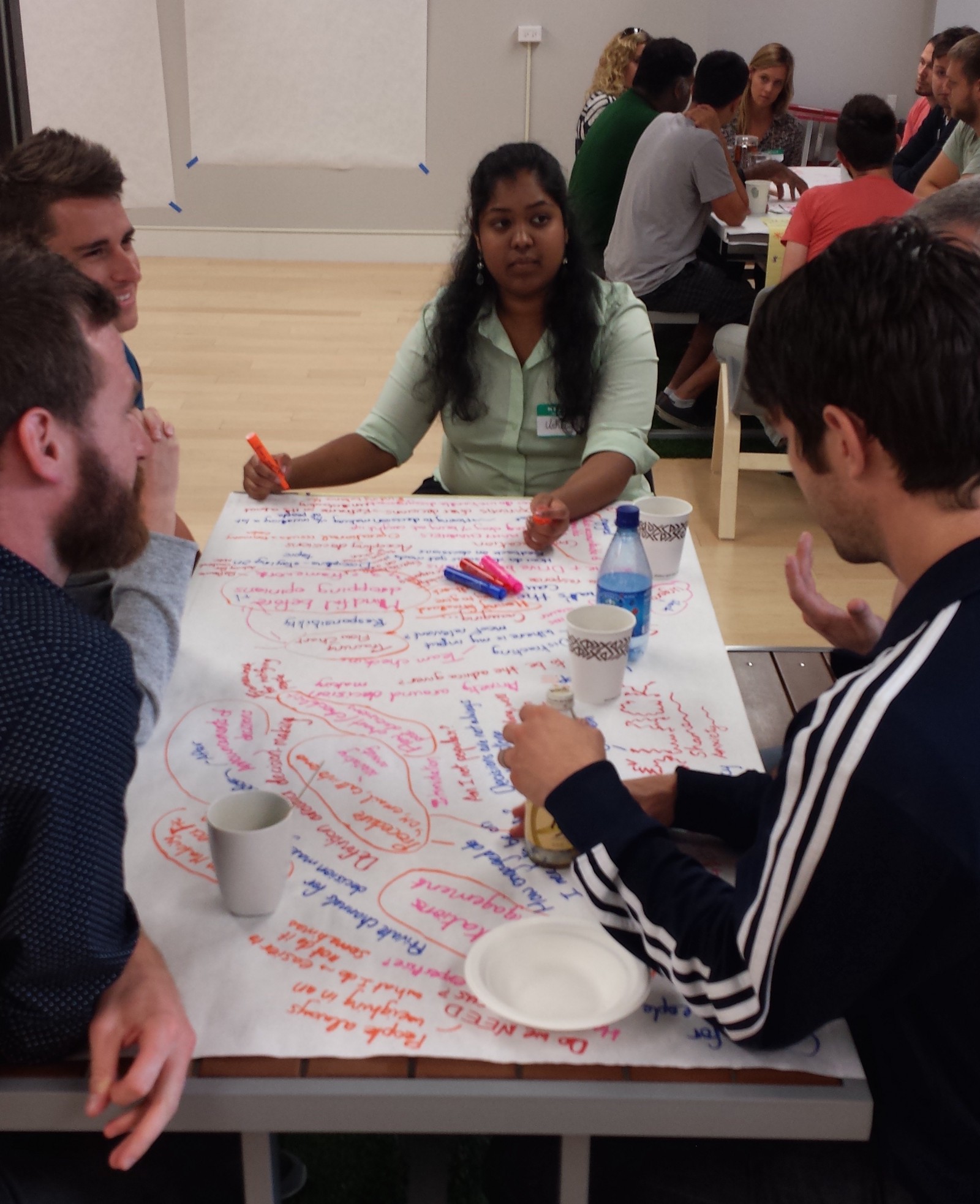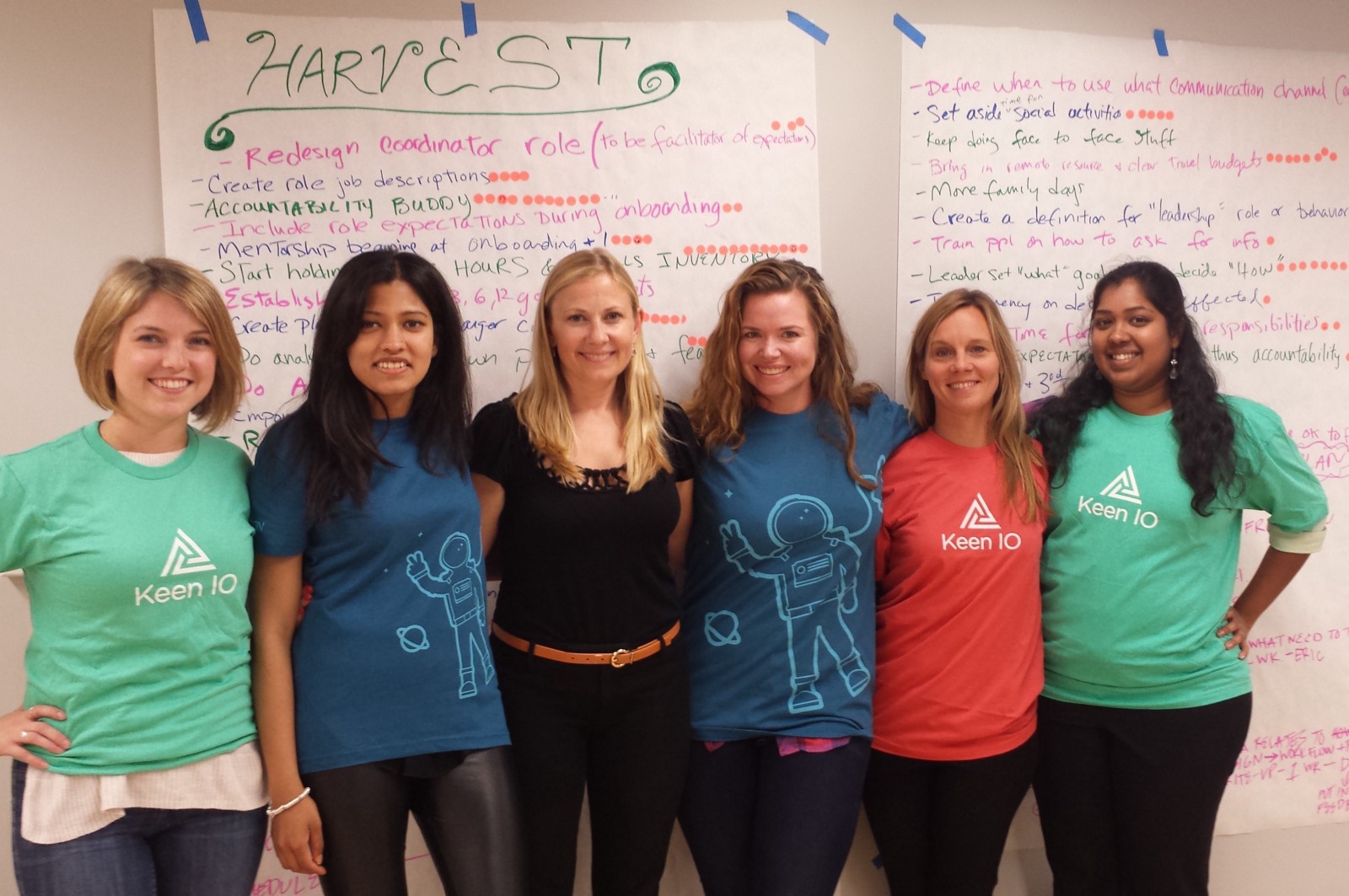What’s wrong with this meeting?
You are likely familiar with the large-scale all-hands or town hall meetings where a large number of people gather. These are often communication “pushes” to provide information or Q&A, but they are not serious work sessions. At worst they are quite boring. And even at their best, it is simply too difficult to have a productive conversation with 50 people, so very little ideating, solutioning, or action planning takes place.
Before joining Keen’s PeopleDev team, I worked as an Organization Development/Change Management consultant. This term does not refer to integrating new updates or features into software, but rather supporting humans during major periods of change within organizations. Restructures, new systems, new ways of working. Basically, the change management consultant’s job is to ensure that the people being asked to adopt these new ways of being actually do so, and ideally, quickly.
I found that one of the most common complaints during periods of major transformation or attempts to scale culture is the slow pace of change. Brilliant new processes, technologies, or organization structures can be designed relatively quickly, but the speed at which people are able to adopt them can be comparatively very slow.
Disrupting the town hall
At Keen we’re always testing, tweaking, and evolving our organizational structure to best suit the needs of the people and the business. As we’ve evolved, we’ve found it’s important to keep everyone aligned on key areas of focus, while simultaneously creating a space for new ideas to emerge.
We tried the traditional town hall, collected feedback, and found it wasn’t really giving people space to contribute ideas and devise solutions to address the true needs of the organization. And yet we knew there were issues within the organization that needed to be addressed.
Instead of holding yet another town hall to identify problems, followed by a series of siloed meetings to try and address them, we decided to host an interactive company-wide working session called the “World Cafe.”
But how do you hold an effective working session with 45 people, you ask? Fabulous question!
The first thing we (the Keen PeopleDev team) did was identify the areas for discussion that would have the greatest impact. We sat down with every employee to collect their input across three topics:
- What is not working at Keen?
- What is working well?
- What do you need right now to do your job better?
After we gathered everyone’s input, we sorted the data into distinct themes to address.
The work session
On the day of the work session, the company gathered in groups of seven across six tables. Jen and I presented the five themes that would be the focus of discussion.
The themes included:
- What to do about too many cooks in the kitchen
- Desired leadership behaviors
- Role clarity and accountability
- How to boost morale and positivity
- Priorities in executing product strategy
- Mystery topic (whatever was fresh on people’s minds could emerge)
Each table was assigned one of the themes, with an outside facilitator stationed at it. There was a paper tablecloth and markers available for people to ideate possible solutions to address the problem described in the theme.

Discussions were limited to 20 minutes (hence the facilitators to keep people focused) and participants were allowed to rotate three times, meaning each participant ultimately had a chance to discuss three of the six themes.
At the end of the hour, a “harvest” was conducted from each of the six tables to create a long list of all the ideas that had been discussed to address each theme. Participants were given stickers to choose the solutions they thought would have the greatest impact on Keen. Once the top ideas/solutions were identified, action planning was conducted on the spot to identify owners, establish clarity around what they would be accountable for, and deadlines.

In less that three hours we had a long list of ideas, decisions, and action plans. Everyone was in alignment and public commitments to action had been made. There would be no need for re-explanations, additional meetings, or approvals.
Results and feedback
Some of the new programs that came out of the World Cafe include:
- Accountabilla-buddy: someone outside of your team to help you stay accountable to your goals
- Team office hours: to reduce constant questioning and requests of different teams
- Skills inventory: so people can identify experts in different programming languages across the business
- Remote on-site: for Keenies not based in San Francisco
- Bike shed reduction program: explicit agreement that you do not need to follow every Slack channel or be constantly up-to-date on all information within the company
In addition to accelerated decision-making and alignment, participants reported a wide range of additional unexpected benefits from the process itself. These included feeling empowered, valued, engaged, connected, heard, inspired, and energized. Here’s some example feedback from the event:
“My voice mattered. I got to hear what other people felt about sensitive topics and felt a sense of relief and validation.”
“Something that had been eating at me — when I heard others had similar feelings, I felt so much more connected to the group and it helped to talk about things that are typically very difficult to talk about.”
“We came out with a list of action items, but even more so, the connections that occurred and speaking directly about things that are not working was likely the most important learning.”
Top 7 tips for holding your own World Cafe
If you’re interested in trying this at your organization, here are the top 7 factors that contributed to the success of the event:
- Try to get the everyone in the room, or at least ensure equal stakeholder representation from each department.
- Have color markers and butcher paper handy at each table so people can take notes and build off of what was discussed in previous rotations.
- Have outside (preferably World Cafe or Organization Development trained) facilitators at each table so everyone in your company can participate.
- Identify the topics that matter before the session. It’s best to collect this data anonymously so people can surface what they might be scared to bring up in a typical all-hands Q&A.
- Coach company leaders to wait to speak at their tables so everyone isn’t waiting to see what they say about a topic before speaking.
- Open the session with a statement that we are going to talk about the things we all know are happening but are not being discussed. Giving permission to name elephants in the room will help make the most of your meeting time.
- Remember that a huge part of the value is the experience itself. The practice of open discussion of tough topics creates communication pathways for feedback loops….an essential habit of learning organizations and key enabler of organization agility!
If you’d like to discuss this event further or want more tips on how to do this at your company, feel free to reach out to me at nielsen@keen.io. Or if you’d like to share your ideas or experiences with different organization improvement exercises, please leave a comment below or tweet me your ideas @redesignod.



